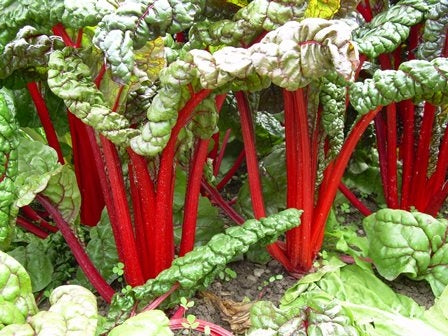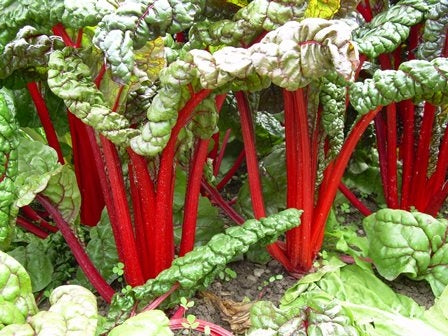FEURIO RIBBED CHARD - ma30
Have a question?

FEURIO RIBBED CHARD - ma30
Dettagli
Scientific name: Beta vulgaris L. var. cycla (L.) Ulrich
Family: Chenopodiaceae
Brief history and botanical notes on the plant
Ribbed chard (Beta vulgaris), native to the Mediterranean basin, is a leafy vegetable; the leaf blade and the highly developed petioles called ribs are consumed cooked. It is cultivated in all Italian regions (especially in Lazio, Liguria, Tuscany and Puglia) and is present on the market all year round, even if its consumption is greater in the winter period.
Chard is a biennial herbaceous plant: the first year the cooked leaves are consumed, while in the second year it is possible to use the roots for the extraction of sugar.
It has a tap root 2-4 cm in diameter and 20-30 cm long.
The basal leaves are gathered together in a rosette and have a spatulate or lanceolate edge, smooth or blistered, supported by a fleshy and flattened petiole (rib) of silver-white, green, pink or red colour, 15-20 cm long.
The flowers are small and greenish in colour, they are grouped in glomeruli of 3-5 leafy spikes, which in turn are grouped in panicles; each flower is made up of a unilocular ovary, 5 stamens and 3 short stigmas; pollination is anemophilous and fertilization is often crossed; flowering occurs in spring-summer and seed harvesting in July-August; the fruit is an indehiscent glomerulus, light to dark brown in colour, containing 3-5 seeds. The duration of germination is 4-5 years (1,000 seeds weigh from 18 to 24 grams).
![chard_380[1]](http://66.71.130.74/wp-content/uploads/bietola_3801.jpg)
Family and variety
Ribbed chard belongs to the same family as spinach: the Chenopodiaceae. There are spring and autumn varieties of chard (more resistant to low temperatures). The cultivars are however distinguished based on the color and blistering of the leaves, size and color of the ribs, and adaptation to the cutting crop. Among these we remember chard with stems that tend towards red and orange, particularly beautiful and decorative, although in Italy the varieties with white stems are better known.
Pedoclimatic needs
Ribbed chard tolerates temperatures of -2 -3°C, while vegetative growth occurs with temperatures above 5-6°C. If the thermal conditions persist below 10 °C for a few weeks during the early stages of development, it is advisable to cover the young plants with non-woven fabric to prevent them from going to seed. It is a rustic plant suitable for all types of soil, although it prefers deep, fresh, well-drained soil with organic substance, with a neutral or sub-alkaline pH, but also tolerates high degrees of salinity well.
Sowing and transplanting times
Sowing can be carried out from mid-April to mid-September, the development of the seedlings requires a wait of approximately 1-2 weeks. The distance between
row is approximately 30-40 cm (depending on the tool used for weeding and weed elimination) while between plants we can keep between 20-40 cm.
Fertilizations
Ribbed chard is an average consumer of N, P and K. It loves soils rich in organic substance and well drained, and does not require particular organic nitrogen fertilizations, the risk of which is only to encourage an accumulation of nitrates in the leaves to the detriment of healthiness. of the product. We recommend compost or mature manure especially for autumn fertilizations.
Crop care and irrigation
After the transplanting phase and throughout the summer period it is necessary to irrigate (at least every 3-4 days) depending on the climatic trend. Avoid unnecessary and dangerous water stagnation due to root asphyxiation.
In the early stages it is advisable to pay attention to weeds which must be eliminated manually or with a grubber.
Adversity
Cercospora or pitting: fungal disease whose infection is favored by high temperatures and humidity, the symptoms are round brown (subsequently black) spots on the sides of the leaves.
To combat this fungus we recommend carrying out processes that allow the water to drain (surface processing, use of organic soil improvers for example) and in the case of a particularly intense attack, the use of copper.
We also point out the use in recent years of spray mycorrhizal fungi to counteract the occupation of ecological niches on the leaf pages "available" to attack by pathogenic fungi. In biodynamics, a decoction of Equisetum arvense can preventatively ensure the management of these unwelcome fungi.
Alltica or ground flea: small beetle (about 12 mm long) of bluish-green color with metallic reflections, particularly on the elytra. The damage is determined by the adult stages; it occurs on the aerial apparatus, especially on young plants with cotyledonary leaves or with the first true leaflets. Altica are active during the hottest hours of the day, passing your hand over the leaves they jump away and hide. Delaying planting can be an effective strategy, in the case of a strong attack we recommend intervening with pyrethrum during the first hours of the day.
Production and collection
After about three months the harvest begins, which is equal to approximately 3-4 kg per m2 (approximately 30-40 q ha), we recommend harvesting in the cool hours of the day, wetting (rinsing) the leaves and keeping them turgid.
Nutritional values
Chard contains vitamins A, C and K and is rich in mineral salts, especially potassium, magnesium and calcium. It contains folic acid and flavonoids useful in the prevention of cancer, it has digestive and laxative properties thanks to its high fiber content.
Biodynamics
We recommend leaf days for sowing and harvesting. If you are transplanting, immerse the roots in water dynamited with 500 (horn manure) or spray 500 in the furrows, this will encourage strong rooting stimulation.


